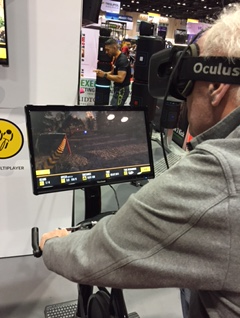.png)
in the zone: David Minton at IHRSA 2016
IHRSA 2016: are you square fit?
When the Leisure Review found out that David Minton was on his way to Orlando to take part in the IHRSA 2016 event we asked whether he would mind putting in a shift as our roving reporter. He was happy to oblige.
.png)
in the zone: David Minton at IHRSA 2016
Almost two years to the day from when Mark Zuckerberg announced that Facebook had purchased the virtual reality (VR) start-up Oculus Rift for around $2 billion, the VR units appeared at IHRSA and Mark’s sister, Randi Zuckerberg, was a keynote speaker.
Sponsored by Matrix Fitness, Randi’s Keynote was titled It’s Dot Complicated and was the first IHRSA keynote to use social media channels to broadcast her inspirational session live. For those who missed it (and in advance of the Leisure Database Social Media Index Report), these are the top five social media channels for fitness professionals.
Number one: YouTube. Video is the way to engage with your audience but few in the UK have this as their priority so far. Six of the top ten public sector brands do not have a channel and only five private brands have over 200,000 views. Number two is Facebook; no surprises there. Facebook is the most common social media platform among UK fitness sites. Number three is LinkedIn. As professionals you can target influencers and expand your network. Four is Instagram. I’ve already banged on about how many public and private fitness brands are neglecting this highly engaging and superior indexing platform. Five is Twitter, the second most popular platform in the UK. Lots of trade suppliers, including MyZone and Precor, used Periscope on Twitter to share their IHRSA showcase live.
On the IHRSA show floor it was like CES (Consumer Electronics Show) meets Fitness. MyZone, Polar, Microsoft, Intel, Reebok, NEO and Garmin were among the main companies who made the move from Vegas in January to Orlando in March, while new technology was evident among almost all companies exhibiting. It seemed like there was an app for everything. Seminars, such as the Fourth Industrial Revolution and the Impact on the Fitness Industry, came from Technogym daily. Precor had a separate section on ‘the future’ and were showing real-time configuration in use in the UK at EasyGym, where you can pay reception for screen access. MyZone moved centre stage with the new app, a sports bra (launched CES 2016), a new integrated T-shirt, group display and a host of online platforms.
As a cyclist I liked the Recon Jet smart eyewear from Intel, also launched at CES. The performance eyewear frame and lenses set wakes up using glance detection to provide live metrics such as heart rate, speed, cadence and power. The point-of-view-camera enables you to capture the moment and the GPS maps can be used to show location of other riders, which is useful when doing endurance rides. Microsoft Health is a good example of a tech company looking for a cause and the Band with continuous optical heart rate monitor, GPS, guided workouts and the usual calls and texts, email and calendar looks and feels too much like the now-defunct Nike Fuel Band.
Wearables and trackers have now been joined by alternate- and mixed-reality technologies that are poised to invade the fitness space. Although the early target market for Oculus Rift are gamers, fitness suppliers such as UK-based Pulse Fitness have introduced gamification for added motivation. Pulse Interactive Fitness combines facial recognition and augmented reality (AR) using Oculus Rift. With a tilt of the head the game starts and the Trixter bike takes you on an AR ride. Linked live to multiplayers worldwide, the results are shown on the bike, in the headset and on a big screen for the local audience. Zumba have developed a 360-degree VR dance class using Oculus Rift. For those who have always dreamed of dancing with Beto Perez, stop dreaming: do it via VR.
Besides Oculus Rift, the HTC Vive is coming, Sony’s PlayStation VR will be with us soon, along with Microsoft HoloLens; and Google is looking to expand Cardboard. The Samsung Gear VR headset, which Oculus also powers, enables you to select the Samsung smartphone to snap into the headset, a combination was used by Zumba. We are at the beginning of a VR and AR journey and, as a result of the billions been spent on this technology, we will all know about this cool, engaging and immersive experience very soon.
As I walked through the event I was struck how the square photograph has become the norm. Square images fill our Twitter streams, Facebook dashboards and of course Instagram. Many of the suppliers know this and have adopted it as standard. Many consumers swipe the phone so photos are square on, permanently. Square is another example of how social media has changed the way consumers experience and report on the world around them. Are you square-on fit?
David Minton is the director of the Leisure Database Company
The Leisure Review, April 2016
© Copyright of all material on this site is retained by The Leisure Review or the individual contributors where stated. Contact The Leisure Review for details.
![]() Download a pdf version of this article for printing
Download a pdf version of this article for printing

On the screen: in the saddle and racing

Before the flood: David unplugged